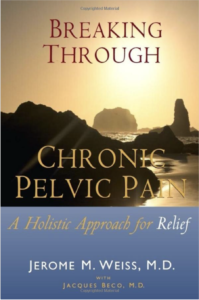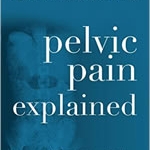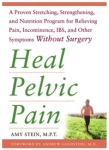Pelvic Floor Dysfunction and Interstitial Cystitis
Pelvic floor dysfunction is commonly found in MEN and WOMEN struggling with interstitial cystitis, vulvodynia, chronic prostatitis and chronic pelvic pain syndrome. Often the result of injury or accident, tight (hypertonic) muscles can cause cramping, burning and difficult urination, defecation and sexual intimacy. Weak pelvic floor muscles are associated with bladder and bowel incontinence, organ prolapse, premature ejaculation, poor orgasm and so forth.
If you’re not sure what the pelvic floor does and why it’s important, check out this award winning video by Gussie Grips, a physical therapist in Scotland. In a funny comedy routine, she shares what the pelvic floor does and how it’s important to incontinence and sexual health. Yet, as she says, with just five trips to a physiotherapist, many pelvic floor issues can be resolved completely!
Pelvic Floor Educational Materials
- The Pelvic Floor Muscles – You have a lot of muscles “down there!”
- PFD Symptoms – Weak vs. tight muscles
- How is PFD Diagnosed? – Pelvic floor assessment should not be feared!
- How is PFD Treated? – Hands on physical therapy, self-care, medications, acupuncture, yoga
- Suggested Books, DVD’s & CD’s
Looking for a Physical Therapist
Finding a PT who has been trained in pelvic floor rehabilitation can be challenging. This is a new area of specialty and comparatively few practitioners have been trained in these new methods. A physical therapist who suggests kegel exercises as a treatment for pelvic pain is clearly NOT trained properly. Kegel exercises are not recommended. The ICN maintains a database of providers based on patient recommendations. You’ll also find a fabulous database of certified pelvic floor therapists at pelvicrehab.com
- ICN Find A Provider Database
- PelvicRehab.com
- International Pelvic Pain Society
- Herman Wallace Practitioner Directory – Herman Wallace is the leading trainer of physical therapists on pelvic floor disorders.
Additional Resources
There are several good books that will help patients understand more about the pelvic floor dysfunction, the anatomy of the pelvis and stretches and exercises that you can do at home that may help.
Breaking Through Chronic Pelvic Pain
 Breaking Through Chronic Pelvic Pain: A Holistic Approach to Relief is the most important book published on IC and pelvic pain in 50 years. Dr. Jerome Weiss, a urologist, pelvic pain and myofascial specialist who practiced in Northern California, devoted his career to unraveling the many potential causes for chronic bladder and pelvic pain.
Breaking Through Chronic Pelvic Pain: A Holistic Approach to Relief is the most important book published on IC and pelvic pain in 50 years. Dr. Jerome Weiss, a urologist, pelvic pain and myofascial specialist who practiced in Northern California, devoted his career to unraveling the many potential causes for chronic bladder and pelvic pain.
Dr. Weiss shares that he was frustrated that current therapies simply covered up the symptoms but did not result in healing. In his book, you will find master class in pelvic anatomy and how muscles, nerves and organs (bladder, prostate, etc.) can influence each other triggering interstitial cystitis, vulvodynia, rectal pain, overactive bladder, prostatitis and more. His caring, compassion and love for patients is shown on every page.
If your IC symptoms began after a trauma (i.e. a fall, surgery, having a child, etc.) he explains how the muscles and related trigger points can compress blood vessels and nerves for long periods of time. This results in poor blood flow and damage to the muscle fibers and nerves, triggering continuous pain that overwhelms the nervous system and spinal cord. While most urologists focus solely on the bladder as the source for their symptoms, he explains that bladder, vulvar, rectal sensitivity (and damage) can also be caused by muscle dysfunction via a somatovisceral reflex.
And if your symptoms began after chemotherapy, estrogen atrophy or infection, he explains how and why muscles and nerves also become involved. And, importantly, that failure to treat each one of these systems can result in long-term suffering. He also shares how devastating stress and anxiety can be to anyone with chronic pain because it can trigger more muscle tension, more neurological dysfunction and lower pain thresholds. Proper nutrition for muscle and organ health is also discussed.
With this book, newly diagnosed patients may be able to catch muscle and nerve dysfunction early. Pay particular attention to the concept of biomechanics and how your hips, legs and feet could be driving continuous pelvic floor muscle tension and dysfunction which, when finally addressed, can result in long-term relief of many urinary symptoms. Patients with scoliosis, one leg shorter than the other, foot disorders (toes pointed inwards, toes pointed outward, Morton’s Neuroma, Morton’s toe, over pronation, etc.) will be stunned to discover that those conditions could be the root of their problems.
The book also includes very clear and detailed treatment plans. He includes dozens of patient success stories that will give you new ideas to explore with your medical team. If you are struggling with recurring flares, if bladder therapies haven’t worked well, if you are worsening rather than improving, this book is a MUST READ and will give you many more options to explore. Click here to learn more and order!
IC Solution
Physical therapist Nicole Cozean tackles the very complex relationship between the bladder and pelvic floor mucles, both of which can contribute to the development of interstitial cystitis. Extremely well written, it offers a simple action plan for patients as they seek relief for their symptoms using both bladder and muscle therapies. This book is a “must read” for both newly diagnosed and veteran IC patients seeking to explore new treatments. Well written and thoughtfully presented, it is designed to empower readers and ensure sure that they are getting the most appropriate treatment and pain care. It is an ideal book for physicians and patients who want a thoughtful and organized discussion of bladder and muscle care. Learn more
Pelvic Pain Explained
 Released in January 2016, authors Stephanie Prendergast and Elizabeth Rummer share the story of how patients develop pelvic pain, the challenges patients and providers face throughout the diagnosis and treatment process, the difficult task of sifting through the different available treatment options, and the impact that an “invisible” condition has on a patient’s life and relationships, and much more. Those who develop pelvic pain find the path to proper diagnosis and treatment frustrating and unsuccessful, oftentimes because they are trying to work within the model of recovery they are used to; one in which they go to the doctor, maybe take some tests and then get a very specific diagnosis that dictates a very specific mode of treatment. This simply is not the path to healing from pelvic pain. Pelvic pain is a health issue that crosses the borders between medical disciplines and requires the patient to be a proactive participant in the healing process. Learn more!
Released in January 2016, authors Stephanie Prendergast and Elizabeth Rummer share the story of how patients develop pelvic pain, the challenges patients and providers face throughout the diagnosis and treatment process, the difficult task of sifting through the different available treatment options, and the impact that an “invisible” condition has on a patient’s life and relationships, and much more. Those who develop pelvic pain find the path to proper diagnosis and treatment frustrating and unsuccessful, oftentimes because they are trying to work within the model of recovery they are used to; one in which they go to the doctor, maybe take some tests and then get a very specific diagnosis that dictates a very specific mode of treatment. This simply is not the path to healing from pelvic pain. Pelvic pain is a health issue that crosses the borders between medical disciplines and requires the patient to be a proactive participant in the healing process. Learn more!
Heal Pelvic Pain
 Written by Amy Stein MPT, Heal Pelvic Pain: The Proven Stretching, Strengthening and Nutrition Program for Relieving Pain, Incontinence, I.B.S. and other Symptoms without Surgery offers readers relief and recovery for pelvic floor disorders through a program of strengthening, stretching and relaxation exercises, massage techniques, nutritional basics, and self-care therapies without drugs or surgery.
Written by Amy Stein MPT, Heal Pelvic Pain: The Proven Stretching, Strengthening and Nutrition Program for Relieving Pain, Incontinence, I.B.S. and other Symptoms without Surgery offers readers relief and recovery for pelvic floor disorders through a program of strengthening, stretching and relaxation exercises, massage techniques, nutritional basics, and self-care therapies without drugs or surgery.
The book provides information for men and women struggling with pelvic pain and shares two different exercise programs. One addresses the pain syndromes related to urinary, bowel, or sexual dysfunction including incontinence, irritable bowel syndrome, urinary and/or bowel frequency, urgency or retention, pudendal neuralgia, prostatitis, endometriosis, pelvic inflammatory disease, and more. The other program addresses pelvic floor muscle weakness and poor coordination resulting in incontinence, pelvic organ prolapse, and/or decreased sexual response. The book is easy to read and use, and offers photos of all of the exercises and massage techniques guide readers every step of the way. Learn more!
